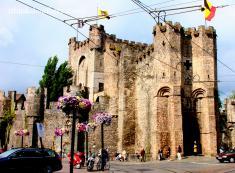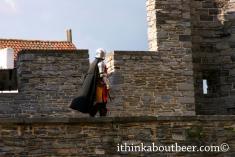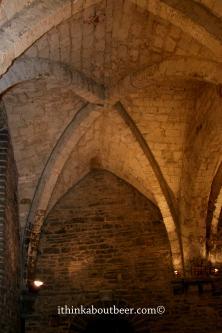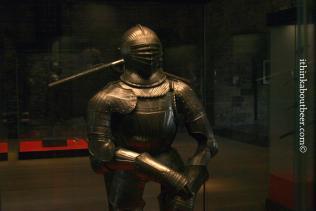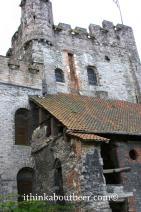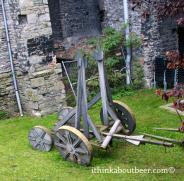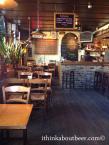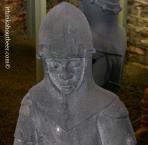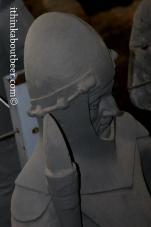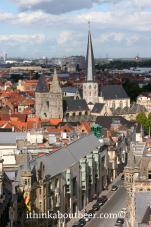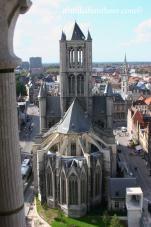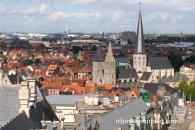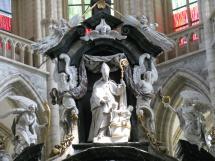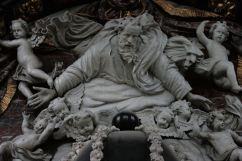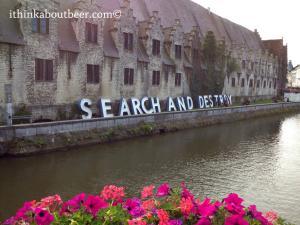
“Search and Destroy” – The Canals of Ghent
Gent or Ghent (depending on your preferred spelling, Gent is how it appears on Flemish maps) is the OTHER story book city of Belgium, or rather the second most famous behind Bruges (Brugge). Ghent features some of the best preserved and oldest buildings in a high geographic concentration in Belgium. It’s not quite as perfectly preserved and restored as Brugge, but it has the advantage of being far less touristy. Ghent grew up around two abbeys founded by St. Arnold around 650 CE. Despite Viking incursions towards the change of the millennium, Gent grew and prospered becoming one of the largest cities in Europe by the 13th century, which was largely fueled by its huge textile industry, the surrounding countryside being ideal for the raising of sheep. Many of the great buildings built during the height of Ghent’s power are still visible today! After that, Ghent began a slow decline as it became a victim of power plays made by major European empires and the intermittent Protestant/Catholic wars.
Fortunately for Ghent, and its historical buildings, both WWI and WWII were gentle on the city. While the Germans did occupy it in WWII, the city was largely recaptured quickly by the British saving the majority of the city from heavy shelling. This set of fortunate historic circumstances have made Gent a wonderful place to visit. The medevil core of the city is full of easily walkable attractions that are made safer by the lack of cars; Gent boasts the largest “car free” zone in Belgium.
Ghent – The Day Visit
Ghent was our first visit after arriving in Belgium and getting settled in with our friends in Antwerp. We maybe could have spent a few more hours there, but we were still recovering from our night at De Kulminator and our encounter with DJ Jan. Like the rest of the country, Ghent is connected to the wonderful train system that links the whole country. If you’re visiting, you’ll want to get off the train at Gent-Sint-Pieters station. Ghent has two stations, the other one gives you better access to the business district. Once you walk out of the station, you will walk over to the street car ticket booth and get a ticket into town. When we were there, there were people helping out tourists at the ticket machine. There are two city trains where you buy your ticket. Board the street car furthest from the main station. It curves into the heart of town and will get you to the tourist sights. You can also get access to one of the city bikes; there’s a huge park of them next to the city trains. We didn’t use them, so I can’t provide advice on what you’ll need to do to get one. Basically, just ride the city train until you see a medieval castle. That’ll be your stop.
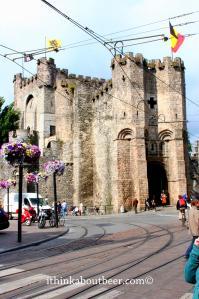
The Rails to Gravensteen
Castle Gravensteen is a Crusader era castle that began construction in 1180 CE, replacing a wooden castle. It became the seat of power for the Count of Flanders until they abandoned it in the 14th century. After that, it served various purposes until it was completely left to decay. In 1885, the city bought the castle and began restoring it. You can, for a small fee of 8€, go inside and walk around the castle and see the displays, including: armor, weapons, a guillotine, torture devices, and more. If you’re a bit sensitive to such things, you may wish to bypass the room displaying the torture implements. The descriptions accompanying them are at times quite graphic.
It’s well worth the 8€. Once you get to the towers, the view of Ghent is great and touring the inside of a 900 year old castle full of artifacts is a lot of fun. Be prepared to climb a lot of stairs though, including some tricky spiral staircases. Bring a knee brace if you’re worried about that old “football” injury you regale everyone with constantly. The day we were there, there was even a guy dressed up as a knight in armor! Despite being clothed in steel, we could never catch up to him for a closeup picture. Dude was a ninja!
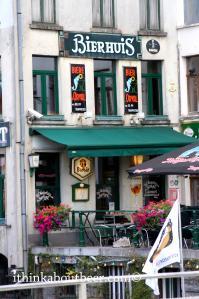
Het Waterhuis ann de Bierkant
After hiking around the castle and its stairs, your next stop should be for a bite to eat and some tasty beer. Across the canal from Gravensteen is the famous Het Waterhuis aan de Bierkant. You can sit outside on the canal patio or head inside and enjoy the atmospheric setting. They have a solid food menu, a nice sized list of rotating draft beer, and an exceptional bottle list with a good variety of Belgium’s offerings. You’ll have plenty of opportunities to drink something new or to revisit an old friend. If you have the time, do both!
Not far from Het Waterhuis is a great hat shop, if you’re into stylish head wear. I picked up a great hat made by Derby Sport, a family owned Belgian company that’s been producing head wear since 1932. Although it was sunny and warm the day I visited Ghent, that hat came in VERY handy when the normally rainy Belgian fall settled in!

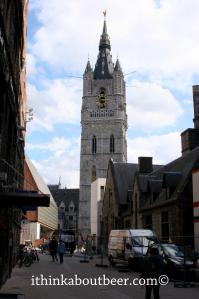
Just look up and start walking, that’s how you find Ghent’s Belfry.
Once you get there, it will cost 5€ for entry. The Belfry, construction started in 1313, is a Unesco World Heritage site. Fair warning: you’ll be doing a lot of stair climbing up narrow, winding spiral stair cases so if you’re claustrophobic, you may wish to be cautious. Going up the stairs is a bit of a chore, going down is a bit of a thrill ride. There is one small section that has an elevator, but if you want to get to very top to see the magnificent view of Ghent, you’ll need to do a lot of climbing.
The main hall has some exhibits that show some of the history of the Belfry and its many uses. The hall used to function as the center for the powerful cloth guild and was later used as a jail and fencing school at various times. Once you head towards the stairs, the first fellows you’ll meet are the tower’s ancient guards, now retired, who used to stand vigil over Ghent from high up on the outside of the tower. 3 of them are replicas while the slightly run down chap is an original. Now start climbing…
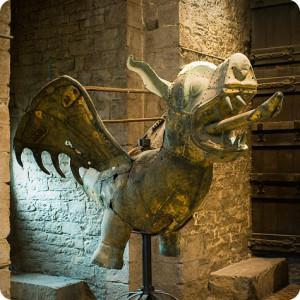
The Real Gulden Draak (Picture from http://www.belfortgent.be/engels/homeen.html)
The first major platform and display area, or rest area if you’re huffing and puffing a bit, features the aforementioned Golden Dragon. This massive metal monster spent a good deal of his life up on top of the tower as a weathervane, which sure beats the rooster you have on top of your house.
At this point, there’s an elevator that will take you up to the next level if you don’t feel like another flight or two of stairs. Although this may seem like the easiest option; the thin, spiral staircases feel far more secure than the modern elevator! On the next floor, you’ll meet the heaviest residents of the Belfry.

Some retired bells (Picture from http://www.belfortgent.be/engels/homeen.html)
As the name belfry or belfort implies, the tower houses bells. Bells that would have warned of invaders, sounded the time, alerted the citizens of important events, and been the sound of daily life in the medieval city. Klokke Roeland used to be the big bell in the belfry; it can currently be viewed in the square next to the tower.
The last part of the climb will take you to what amounts to the observation deck of the tower. You can get a spectacular 360° view of Gent. It’s well worth all the effort to make it to the top. In the foreground, you’ll get a bird’s eye view of old Gent with the background filled with modern Belgium. After you’ve soaked in the view, now begins your thrill ride to the bottom. Going up the narrow windy and spiral stairs is one thing, going down is another. Be careful!
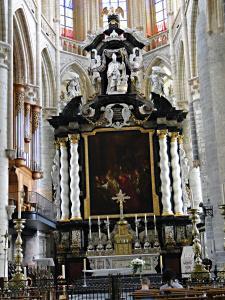
The Altar in St. Nicholas Church (Photo by Richard White – Flickr, http://www.flickr.com/photos/gauiscaecilius/)
After you make it safely to the bottom, a short walk will take you to St. Nicolas’s Church. St. Nicholas’s was constructed in the 13th century and it’s tower was the tallest in Ghent until the Belfry was finished. This Scheldt Gothic cathedral is open to the public and is well worth the visit to see the famous organ and the altar piece. The art within Cathedrals is often ornate and stunningly beautiful, and St. Nicholas is no exception.
With that, we found a place for dinner then headed back to Antwerp. Ghent was a fun first trip. While we only hit a few of the many attractions of Ghent, we had a great half day exploring one of the great cities of both Medieval and Modern Europe. Fortunately, that leaves a lot of Ghent to explore on my next trip.
If you want to see a wide variety of Medieval buildings without a lot of traveling, Ghent is your place to go. You can visit a castle, cathedral, belfry, clock tower, and more with only a short amount of walking between. Some of these places will require some stair climbing, but nothing worth doing is completely free from cost, be that a few Euros or some physical effort. Ghent is definitely worth doing.
